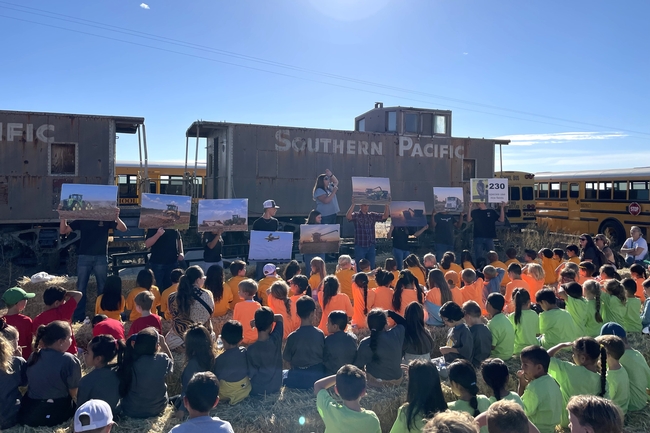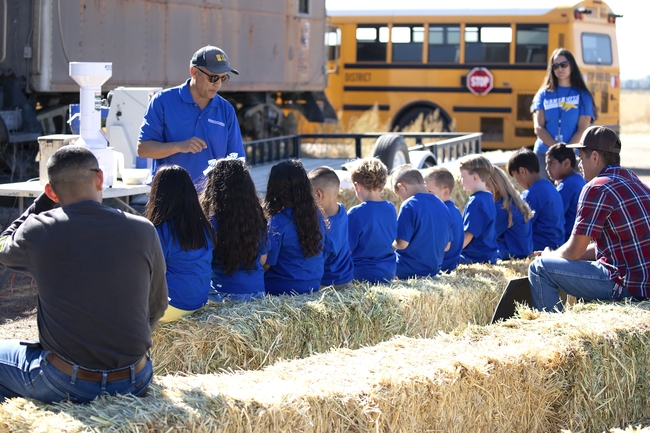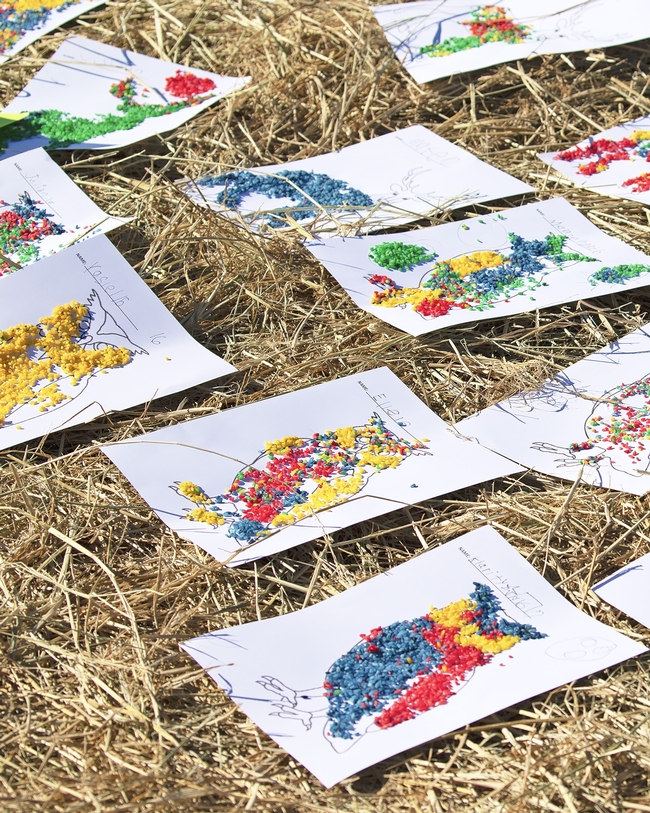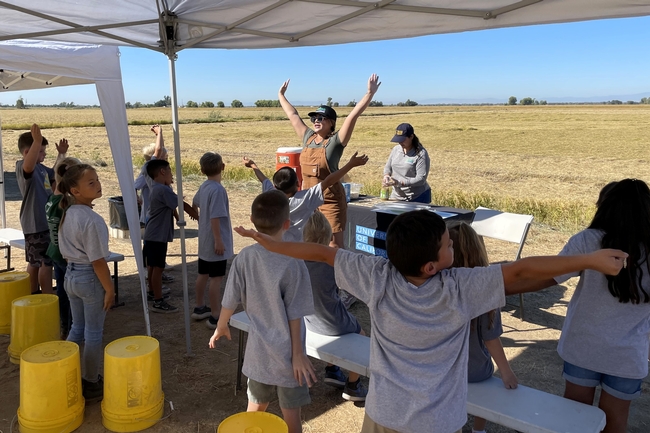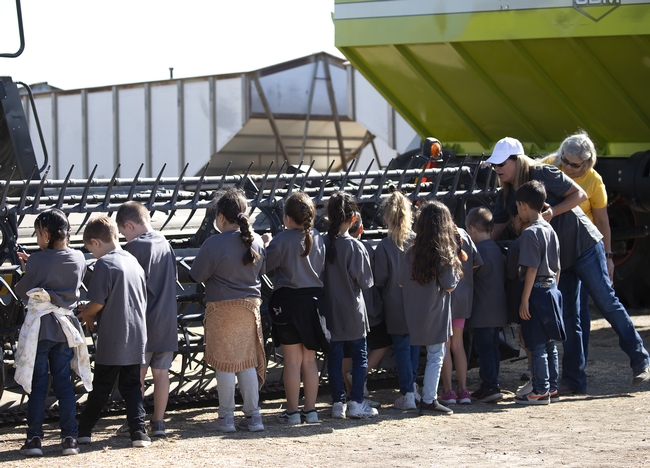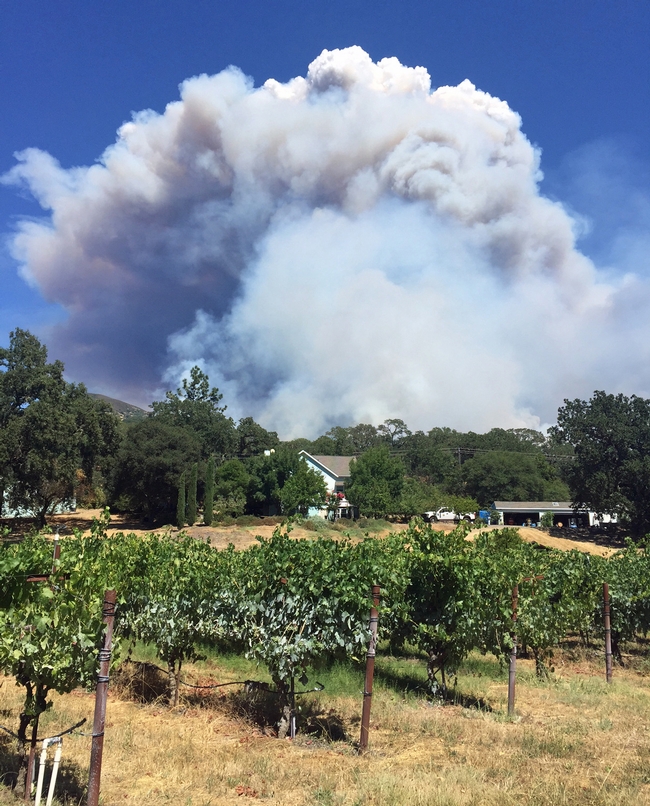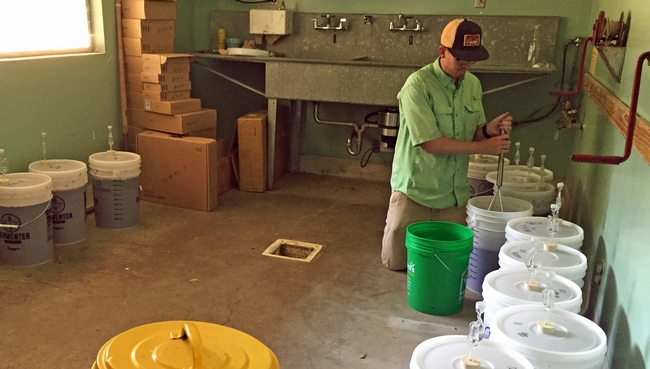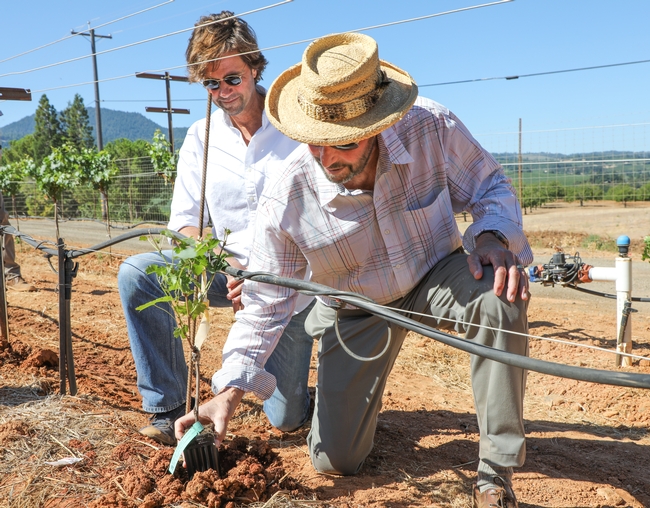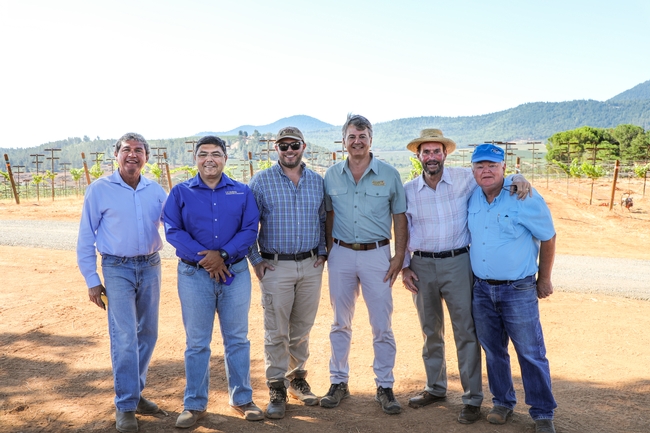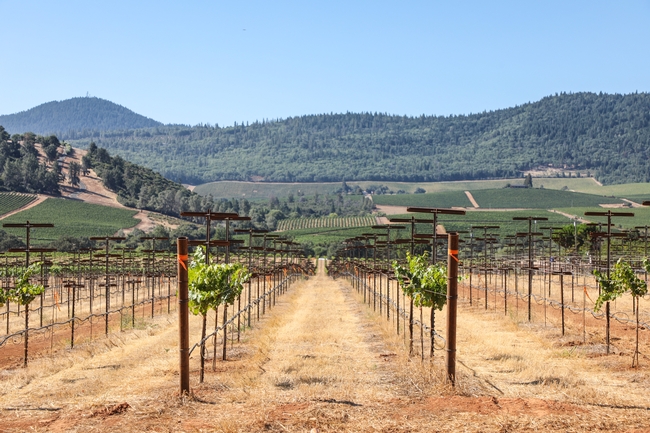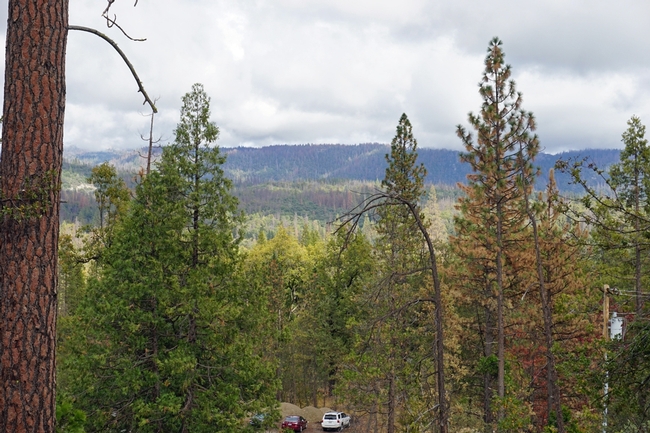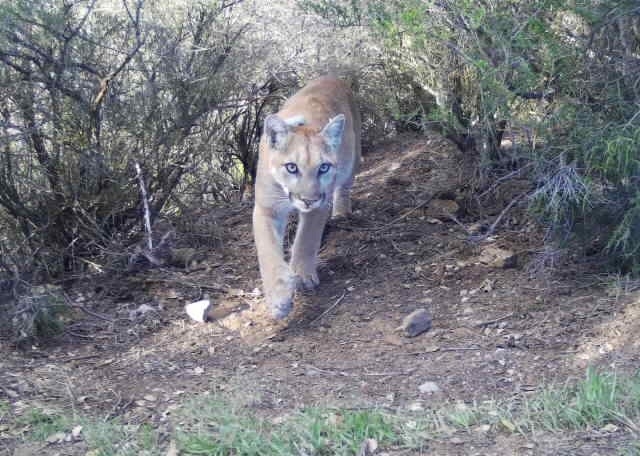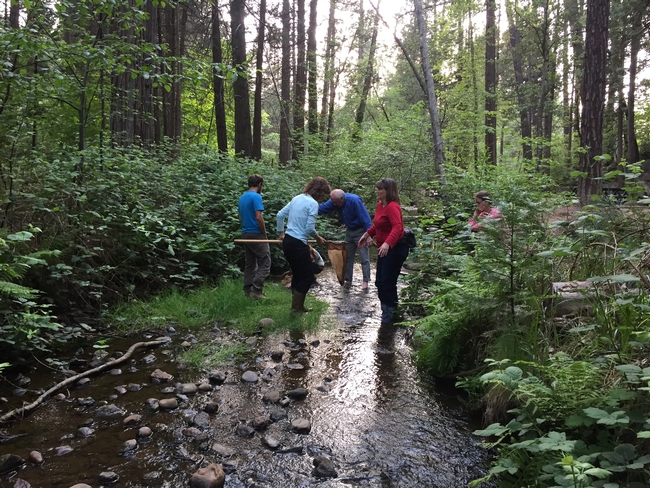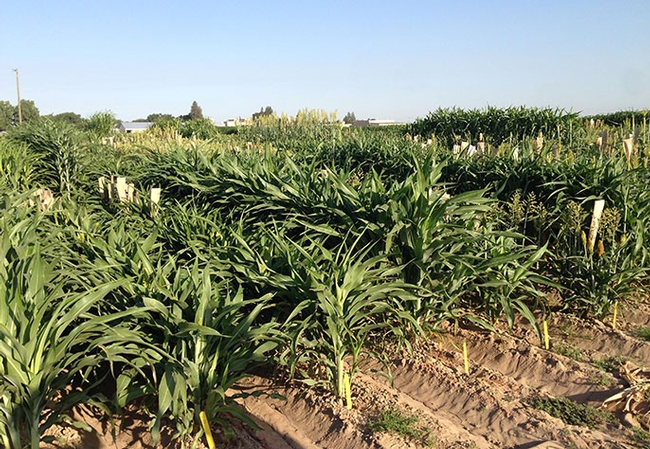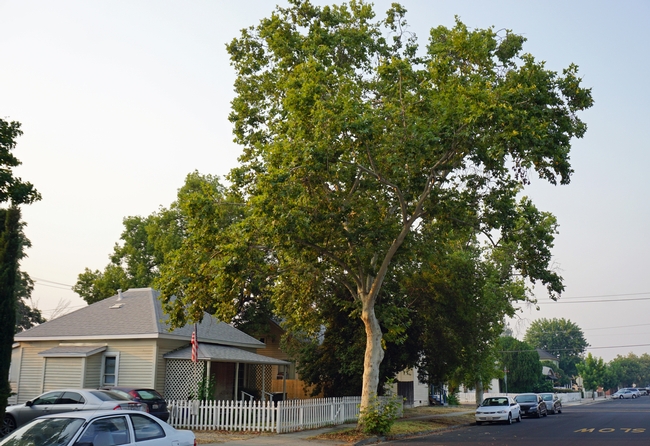
Posts Tagged: Glenn
Butte County first graders enjoy ‘ricetastic’ day at local farm
UC Cooperative Extension advisors, educators join growers in showcasing rice production
When Tracy Schohr volunteered in her son's pre-K class a couple years ago, she was stunned to find out that only two of the 20 children had ever been around a tractor. And this was in the rural Butte County community of Gridley, in the heart of California's rice-growing region.
Seeking to introduce more young children to agriculture, Schohr – the University of California Cooperative Extension livestock and natural resources advisor for the area – and her friend Lisa Donati created an event to showcase rice farming.
After the debut of “Ricetastic Day” last year with about 140 students from Gridley in attendance, this year's event on Sept. 19 attracted more than 240 schoolchildren – this time from across south Butte County.
First graders from McKinley Primary School in Gridley, Manzanita Elementary School, Biggs Elementary School and Richvale Elementary School – along with their teachers and many family members – enjoyed hands-on experiences at Schohr's rice and cattle ranch.
“There's a dwindling population that produces the food that we eat across America, so how can we have more people know, appreciate and love agriculture if we don't give them that opportunity?” said Schohr. “That's what this day is really about – to teach them about rice, to teach them about their community, how healthy rice can be, and how the farming and ranching can also create habitat for wildlife. It's all-encompassing.”
Event stations share different aspects of rice
Schohr, who grew up on the family ranch in Gridley, remembers coming with her McKinley schoolmates for a visit. But those field trips had comprised only lunch and a quick “drive-through” tour of the historic farming operation.
For Ricetastic Day, however, Schohr organized – with generous help from local growers and community partners – a more comprehensive half-day of activities. After her brother, Ryan Schohr, welcomed the participants to the family farm, the students formed groups that were led by Gridley FFA youth on a rotation through a variety of stations.
At the milling station, Luis Espino, UCCE rice farming systems advisor, demonstrated how his mini mill machines remove the husks from rough rice to make brown rice, and then polish away the bran layer to make white rice. He had the children see and feel the difference as the rice moved through processing.
“I didn't even know brown rice existed!” exclaimed Elsie, a first grader at McKinley.
A native of Peru, Espino came to study agriculture through his lifelong fascination with biology and living things – and he said events like Ricetastic Day can inspire a similar passion in young people.
“It might spark their curiosity so that they might go into these areas of work in the future or have a career in agriculture, when they see that people do this for a living,” Espino said.
Ray Stogsdill, another McKinley school alumnus, returned to Gridley after college to pursue just such a career. A staff research associate in the lab of UC Davis professor Bruce Linquist, Stogsdill manages on-farm rice variety testing across the region. He volunteered to help Schohr with Ricetastic Day by talking about some of the heavy equipment and providing his perspective for the kids.
“They drive by the fields and they don't know what's out there,” he said. “This gives them a chance to know what they're driving by, so they can say, ‘We have rice here and this is how it works; this is how it grows.' It gives them an idea of what's going on around them.”
Where rice fits within a healthy diet was the focus for the CalFresh Healthy Living, UC Cooperative Extension team, comprising nutrition educators Sunshine Hawjj, Joanna Aguilar and Kenia Estrada, as well as community nutrition, health and food security advisor Veronica VanCleave-Hunt. They talked about how rice – like other grains in that vital food group – gives people energy, and then taught the students an energetic “ricetastic” movement activity.
“Because our program is part of UC Agriculture and Natural Resources, it's important to make the connection between where our food comes from and how it gets on our plate – especially with young kids, so that we can promote value for our local agriculture and our food systems,” VanCleave-Hunt explained.
Activities spark further conversations, learning about agriculture
With rice harvest late due to late planting in the spring, Eric Waterbury of Waterbury Farms was able to take some time to attend the event. Although his family has been growing rice for three generations, he said he appreciates opportunities for the broader community to see all aspects of his work – from the equipment to the processing.
“If the kids walk away from this with one thing, I hope it's that they realize every time they have a meal, somebody was out there working hard to provide that meal,” he said. “It wasn't just the person at the grocery store that provided it for them.”
Schohr added that Ricetastic Day was only possible through the support of the community. Butte County Farm Bureau and Natural Resources Conservation Service staff helped kids make art with colorful dyed rice; neighboring farmer Tinker Storm described how the harvester and “bankout” wagon work; and rice farmers Shelley Beck and Sue Orme read aloud “Daddy's Got Dirt: A California Rice Story,” a children's book written by a local rice grower.
With rice at the center of physical activities, arts and crafts, and science lessons for the day, the students learned a lot to take home.
“It's nice that the kids got these hands-on learning experiences,” said Ryan Schohr, “so they can go home tonight and, at the dinner table, talk about it with their parents or brothers and sisters, over dinner or over homework – and share what they learned here on the farm and about their community.”
Rebecca Christy, a first- and second-grade teacher at Biggs Elementary, said she is excited to return to the classroom and hear from her students about all that they learned during the day.
“Every morning right now I'm seeing the big trucks going by our school, and so I'll be able to point that out to them, ‘Where are they going? What are they doing?'” she said. “I can't wait to get back to school and let them tell me about all of this.”
One of her students, Ximena, was finishing her brownbag lunch as the group watched one of the Schohr Ranch harvesters rumble over the field. Despite enjoying a rice cake and a rice cracker earlier, she said her meal was missing one thing.
“Where is my rice, Miss Christy?” she said. “I want rice!”
Ten UC Cooperative Extension academics retire July 1
- Jose Aguiar
- Rachel Elkins
- Beth Grafton-Cardwell
- Allan Fulton
- Kurt Hembree
- Anna Martin
- Glenn McGourty
- John Roncoroni
- Rhonda Smith
- Cheryl Wilen
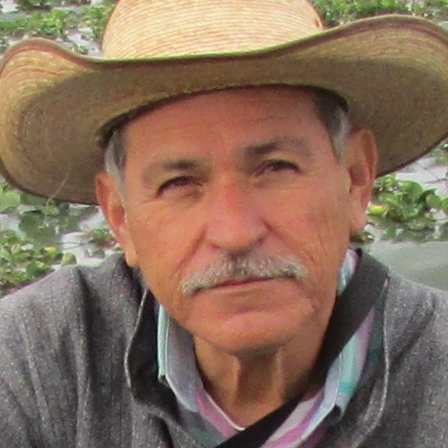
Jose Aguiar, who has been working as a vegetable crops small farm advisor for the University of California Cooperative Extension in the Coachella Valley in Riverside County since 1992, will retire on July 1.
"My job is one of the best jobs in the world. I enjoy the research and education that we provide our community. From the beginning, there was so much to learn, and it has been that way every day on the job," Aguiar said.
What started many years ago to help his family economically became a passion turned into a career. He was 12 years old when, alongside his father, he started working in the Coachella Valley agricultural fields.
"When all my friends went on vacation, I was going to work in the fields. It was my turn to sow asparagus, harvest okra. I did not like it at all because you have to put on a long shirt, because pollen scratches you a lot; it is a very difficult crop to harvest," remembers Aguiar.
Aguiar specializes in bell pepper, which was a great help in 2012. That year in the Coachella Valley, a microscopic worm threatened the bell pepper and chili crop that had an estimated value of $90 million. UC Agriculture and Natural Resources experts worked with farmers to understand why it was a problem there and not in other pepper growing areas. That's where the idea of creating a UC ANR pepper workgroup to research these problems came about.
“Meeting with the small scale producers, I had a list of 12 or 15 problems,” Aguiar said. “I started to speak with other advisors about having a conference for limited scale producers where we could present them with research based information. I invited all the small farmers, and we covered production problems, insect and disease problems, postharvest and even marketing of their particular crops."
Aguiar expressed the essence of his 20 years of passion at work: "I have enjoyed presenting research-based information to farmers and pest control advisers. I have enjoyed walking in many fields and seeing and hearing about the problems firsthand. I have enjoyed working with the small farmers and addressing some of the issues, such as producing a crop with a limited budget. I have enjoyed collaborating with many UC farm advisors, specialists, and the local agencies involved in agriculture. I have enjoyed working with groups doing and working on community gardens."

Rachel Elkins, UC Cooperative Extension pomology farm advisor for Lake and Mendocino counties, plans to retire July 1 after 36 years at UC, 33 years in her current position.
“Rachel has been invaluable to the pear industry in Mendocino and Lake counties,” said Bob McClain, California Pear Advisory Board's field and research director.
After earning a bachelor's degree in international studies at University of the Pacific and a bachelor's degree in agricultural pest management at UC Berkeley, the Richmond native landed an internship helping UCCE integrated pest management in Fresno County in 1982. After earning two master's degrees, in pomology and plant protection and pest management at UC Davis, Elkins joined UCCE as a farm advisor intern in 1986 and became a farm advisor in Lake and Mendocino counties in 1987.
“I began with zero knowledge about pear production, my main assigned crop,” Elkins said. “From this beginning, I dived in; I am still learning every day. I am fortunate to have developed close working relationships with UC, industry and colleagues in Oregon and Washington, as well as other states and countries where pears are grown.”
She co-edited and co-authored over 200 publications. Her most recent co-authored article on predatory phytoseiid mites was just published in California Agriculture journal.
Elkins is known for her research to control codling moth populations by interfering with the insect's sex life instead of using insecticides. Releasing pheromones confuses male moths seeking mates. Working with UC Riverside researcher Harry Shorey, “she was instrumental in developing pheromone puffers for codling moth control,” McClain said, noting that pheromones distributed in orchards on plastic ties were hung by hand 200 to the acre. “With the puffer, you needed two per acre, which saved on labor costs.”
A 2003 UC cost study showed that the pheromone puffers saved growers $9 per ton or nearly $200 per acre, based on 20 tons per acre. The California Department of Pesticide Regulation honored the project with its 2000 IPM Innovator Award. The puffer is now used on nearly all the pear acreage in Lake County. This success in pears led to its use in apple and walnut orchards.
Although pears are her specialty, she has worked with more than 25 fruit and nut crops, including walnuts, apples, kiwifruit, olives and wine grapes. In 1993, Elkins started the UC Master Gardeners Program in Lake County, which is still going strong today.
“My walnut research program has greatly increased in the past decade as higher prices and organic markets have led to new Lake County plantings,” she said. “I established four long-term rootstock trials in 2011-2012, which are providing local growers with important data to decide whether to replace seedling Paradox with newer clonal selections.”
In 2015, she received the American Society for Horticultural Science award for Outstanding Extension Education Materials for her video “Budding, Grafting and Planting Walnut Trees,” honoring renowned Lake County nurseryman Alex Suchan.
Elkins, who was granted emeritus status by UC ANR, will return part-time, funded by the California Pear Advisory Board and Pear Pest Management Research Fund, to continue research assisting the statewide pear industry.

Long time UC Cooperative Extension advisor Allan Fulton said his interest in agriculture started young and never waned. He will retire July 1 after nearly 35 years working in the industry. Most of his career was in extension, first in Kings County and later serving Tehama, Glenn, Colusa and Shasta counties.
“From the time I was tall enough to see over the steering wheel of an old flatbed pickup to guide it while my uncle fed hay to cattle in snow-covered pastures, I knew I wanted to be involved in agriculture,” Fulton said. “There's nothing like the rewards of a good day's work growing food or fiber, whether it was stacking hay, branding cattle, irrigating corn and alfalfa or harvesting the crops.”
Fulton earned bachelor's and master's degrees at Colorado State University, Fort Collins, in agronomy, soil and irrigation science. In 1986, he was named the soils, water and winter grains advisor for Kings County UC Cooperative Extension.
For over 11 years, Fulton developed, demonstrated and taught irrigation management practices for orchard and agronomic crops in order to improve efficiency. He conducted research on soil and water amendments to manage soils with slow water infiltration, and evaluated salt tolerance of agronomic crops, trees and halophytes, plants that thrive when irrigated with brackish drain water. He also conducted research to introduce improved small grain varieties and fertility practices to produce high protein cereal grains.
In 2000, Fulton returned to UCCE as the irrigation and water resources advisor in the northern Sacramento Valley, a position he would hold for more than 20 years. Fulton worked on developing irrigation and soil management practices for orchard and agronomic crops that sustain production, use water and energy efficiently and prevent off-site water quality impacts. He also teamed with other water resource professionals to help farmers and allied industries understand aquifer systems, groundwater management approaches and conjunctive water management concepts.
“I will always be grateful for the countless acquaintances, conversations and collaborations. Many thanks to the growers, my UC colleagues, consultants and policy makers throughout the Central Valley who worked with me over the years,” Fulton said. “I value our precious land and water resources and our agrarian-based society and hope I have contributed to its sustainability in some small way.”
In retirement, Fulton and his wife plan to stay in Red Bluff, where three of their five children and four of their seven grandchildren live close by. And he won't abandon his commitment to agriculture either.
Fulton plans to volunteer one day a week at UC Cooperative Extension to continue a few projects still underway. There will also be time to enjoy other pursuits, he said.
“My wife and I hope to travel the U.S. and Canada,” he said. “That is in God's hands, but we're looking forward to helping others where we can and experiencing what is in store for us.”
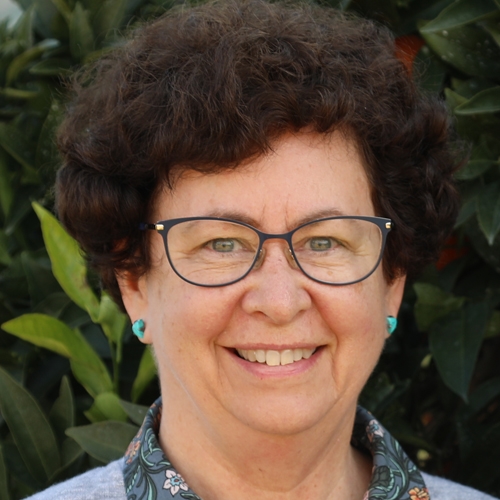
UC Cooperative Extension specialist Beth Grafton-Cardwell retires July 1, a hero in the battle against pests that threaten the livelihood of citrus growers in California, and a successful advocate for reducing use of broad spectrum pesticides.
Grafton-Cardwell – who holds a bachelor's degree in biology from UC Berkeley, a master's in entomology from Purdue University and a doctorate degree in entomology from Berkeley – was named the UC Riverside citrus entomology specialist for the San Joaquin Valley in 1990. Her initial focus was on helping growers reduce their use of harsh pesticides through careful pest monitoring, choice of selective pesticides and preservation of natural enemies.
Along with her staff, Grafton-Cardwell studied the release of predatory mites for control of thrips and mites, validated degree-day units and pheromone traps for citrus cutworm, determined the effects of insect growth regulators on vedalia beetle (a natural enemy of cottony cushion scale), studied the best use of more than 30 new insecticides and miticides, and monitored pesticide resistance of California red scale and citrus thrips.
“It has been a wonderful career full of interactions with colleagues, growers and pest control advisors who shaped the direction of my research,” Grafton-Cardwell said.
During the last decade of her career, pesticide use in citrus has increased once again because of three issues: The drought and increasing temperatures exacerbating pests, new treatments required for pests of export significance, and invasive pests, most importantly the Asian citrus psyllid that can spread the devastating bacterial disease huanglongbing.
“It has been very rewarding to help growers navigate these challenges,” she said. “We have innovative citrus growers in California and excellent scientists at UC. I have every confidence that they will be able meet these challenges and maintain a vibrant California citrus industry.”
In June 2006, Grafton-Cardwell was named director of the UC Lindcove Research and Extension Center in Exeter, a 175-acre facility that supports research projects on citrus breeding, horticulture and pest management. Last year, Grafton-Cardwell hosted the launch of a fundraising program to build an educational complex at Lindcove to be called the Ray Copeland Citrus Center.
“Expanding the capacity of the Lindcove REC to conduct research and extension programs has made the directorship a very rewarding experience,” she said.
In retirement, Grafton-Cardwell plans for frequent travel to visit her children and grandchildren in Missouri and Massachusetts, working with community organizations in the Visalia area and, as an emeritus specialist, writing up past research and assisting with Lindcove's fundraising campaign.

Retiring UC Cooperative Extension weed science advisor Kurt Hembree credits his mentor and predecessor, Bill Fischer, for his successful 26-year career conducting a weed research and extension program for farmers in Fresno County.
“He instilled in me a real appreciation for both the art and science behind weed management,” Hembree said.
Hembree started working as Fischer's agricultural assistant when he was a plant science student at Fresno State. After graduation in 1986, Hembree was promoted to staff research associate, a position he held for eight years.
Recognizing the opportunity to succeed Fischer in his academic role, Hembree returned to Fresno State to complete a master's degree. Fischer retired in 1994 and Hembree was named UCCE weed science advisor later the same year.
Hembree said he was privileged to work with a tight-knit group of academic and non-academic staff, growers, consultants and the allied industries.
“Everybody knew everybody. I developed strong friendships over my career,” he said. “I cherish that.”
An early research success set a course for the future.
The weed nightshade posed a significant problem in seeded fields of processing tomatoes, a plant in the same family. Hembree conducted trials on a new product that selectively removed the nightshade.
“That was a major breakthrough,” Hembree said. “We were able to get the product labeled for tomatoes and it made a huge impact right away.”
That was just the beginning.
“When I came on board, there weren't many products registered for weed control in orchards, vineyards and agronomic crops,” Hembree said. “We worked closely with the industry and there were lots of opportunities to look at new products. These new tools were economically sound and reduced the hard labor of hand weeding.”
In retirement, Hembree plans to move with his wife to northern Mississippi to be closer to family.

Anna Martin, UC Cooperative Extension nutrition, family and consumer sciences advisor in San Joaquin County, devoted her career to the health and wellness of youth and adults locally and statewide. She retires July 1 after 26 years serving in various UCCE roles that focus on nutrition, food safety, physical activity and food security education.
With a bachelor's degree in home economics from California State University in Sacramento, Martin took a part-time position in 1993 as an educator with the Expanded Food and Nutrition Education program in San Joaquin County. A year later, she was elevated to full time to also work on the Food Stamp Nutrition Education Program, which is now called CalFresh Healthy Living, UC. Both programs are federally funded initiatives administered by UC Cooperative Extension to help low-income families use their food budgets to put healthful meals on the table.
In 2001, Martin completed a master's degree in community nutrition and was named to the academic position she held in San Joaquin County the next 19 years.
“I designed my program to promote individual, community, system and environmental changes to positively impact the health behaviors of low-income youth and families,” Martin said. “Working with my colleagues across the state, we sought to understand and address obesity and chronic disease prevention, health disparities, food safety and food insecurity.”
Martin studied the health behaviors of low-income populations to develop curricula, delivery methods, evaluation tools and other materials that could be incorporated into the education programs. Over the years, Martin co-authored 26 peer-reviewed publications, 62 abstracts or posters, and 52 non-peer reviewed publications or reports.
Despite these many achievements, Martin said she most valued the interactions with current and past co-workers and colleagues in San Joaquin County and across the state, the people she describes as her “work family.”
“I think the experience has been so positive because we come together around projects and programs that make a difference in the health and welfare of the families we serve,” Martin said. “My years with Cooperative Extension have created strong bonds within UC ANR and within my community that I foresee will last a lifetime.”

When Glenn McGourty joined UC Cooperative Extension as a plant science advisor in Mendocino County in 1987, he was one of the first farm advisors in the state to have support for organic and sustainable farmers written into his job description. He helped transform Mendocino County into an environmentally friendly farming leader in California. McGourty retires July 1.
After earning a bachelor's degree in botany at Humboldt State and a master's degree in plant, soil and water science at the University of Nevada Reno, McGourty worked as a Cooperative Extension urban horticulturist in Las Vegas. Later he was a lecturer in the Environmental Horticulture Department at Cal Poly, San Luis Obispo, and managed his family's walnut farm in nearby Paso Robles part time.
When McGourty was named a UCCE farm advisor, UC was beginning to endorse a systems approach to sustainable farming.
“I was certainly one of the people who took it to heart,” McGourty said.
In the late 1980s, most grape growers in Mendocino County disked the soil in vineyard rows every year to reduce weeds. Insecticides were applied that kept workers out of the vineyard for three weeks.
“Vineyards seemed pretty barren and not friendly to nature. We had a lot of soil erosion and water quality issues,” McGourty said. “My colleagues and I tried to find solutions that would boost soil organic matter and encourage beneficial insects and mites. One of our landmark research projects was coming up with good cover cropping systems for wine grapes.”
Those practices are widely implemented today, and across California interest in soil health and sustainability continue to grow. McGourty was assigned to also serve Lake County, where wine growers there adopted a strong interest in sustainable wine-growing practices.
“We have the Healthy Soils Program, in which CDFA is paying farmers to grow cover crops and use compost to sequester carbon in the soil. This came out of our research on alternative farming systems conducted in our region,” McGourty said.
Another research interest has been evaluating wine grapes from the Mediterranean region adapted to warm climates.
“After many years of working with ornamental plants, I realized that the plants that do best in California are all from a Mediterranean climate region,” McGourty said. “It made sense for me to look for wine grape varieties that like that climate, too.”
McGourty has been honored by UC ANR with emeritus status. As an emeritus advisor, McGourty plans to work on a national online database of wine grape varieties adapted to warm climates and a Lake County wine grape research project.
Retirement promises to be busy for McGourty. In March, he received the most votes in the primary election for a position on the Mendocino County Board of Supervisors. He will be immersed in campaigning until the runoff election in November.
Even if the election doesn't go his way, McGourty won't be idle. He manages a 10-acre wine grape and walnut farm on the Russian River, where he farms with the sustainable practices he taught local farmers during his career.
“I am so lucky! I have had one of the best jobs in UC and live in one of the prettiest places in California,” he said.

After 38 years of service, John Roncoroni, UC Cooperative Extension advisor specializing in vineyard weed management in Napa County, plans to retire July 1.
Over the years, Roncoroni has become a trusted resource for weed management research and extension, not only in the North Coast, but throughout California. He is known for his research on conventional and organic herbicides, hedgerows in vineyards, irrigation pond weed control, and sheep for grazing weeds in commercial trees and vines.
“Over the years working with John Roncoroni, I experienced firsthand his dedication, passion and knowledge to educate farmers and agricultural workers – both in English and Spanish – about best management practices to control and eradicate invasive weeds and weeds of concerns for the agricultural industry. John will be missed greatly,” said Jose Chang, Monterey County assistant agricultural commissioner and former deputy agricultural commissioner in Napa County.
After earning a bachelor's degree in environmental policy analysis and planning at UC Davis, Roncoroni began his career as a UC Davis postgraduate researcher in 1983, then became a staff research associate working with other weed scientists in crops, forest and rangelands. He earned an master's degree in horticulture at UC Davis in 1999.
In 2007, when Roncoroni became a UC Cooperative Extension advisor in Napa County, most conventional grape growers used glyphosate, or Roundup, for the weed control.
“In fact, Roundup only was considered the most sustainable weed management method,” Roncoroni said. “This over-reliance on glyphosate resulted in biological resistance by weeds.”
He taught growers about alternative herbicides and non-chemical weed control methods and how to make these methods more effective. Little did he know that this research would become even more valuable when some consumers began to object to glyphosate use.
Because he has studied weed management in a broad array of environments, Roncoroni is often asked by UCCE colleagues to give weed control tips to different audiences ranging from golf course turf managers to small-scale Mien strawberry farmers.
“Over the years I have had the opportunity to work on weed control in forestry, rangeland, row crops, alfalfa, fruit and nut trees, but it was my early training in weed management in turf and ornamentals, mulches and alternative weed control that added to my effectiveness in teaching weed control to urban audiences and to training UC Master Gardeners,” said Roncoroni, who has trained more than 1,700 UC Master Gardener volunteers in weed identification, biology and management.
Roncoroni's expertise has been recognized by the California Sustainable Winegrowing Alliance, which asked him to assist in writing their standards for sustainable winegrowing, and the California Department of Pesticide Regulation, which asked him to serve on its Pest Management Advisory Committee. In 2018, the California Weed Science Society named Roncoroni an Honorary member, its highest honor.
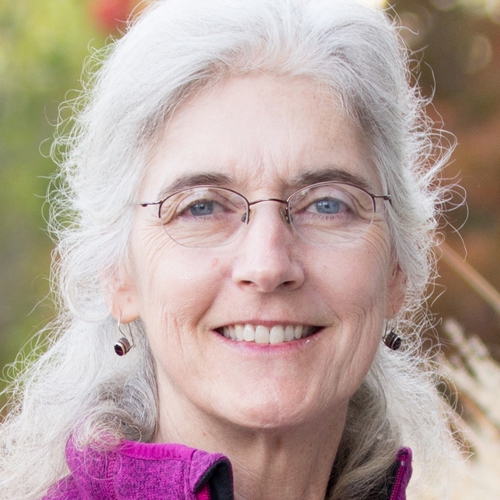
Rhonda Smith has been heralded as the “heroine of the vineyards” for her groundbreaking work in helping combat the parade of pathogens and other problems that have plagued Sonoma County grapevines – and alarmed growers.
A scientist first and foremost, Smith steadily emerged as Sonoma County's expert on all things wine grape during her nearly 34 years as a University of California Cooperative Extension viticulture advisor. Over the decades, she used her scientific know-how, meticulous research methodology and incredible work ethic to advance wine grape production in Sonoma County.
She cultivated working relationships with growers and vineyard managers, setting up field trials and collecting data in vineyards throughout Sonoma County. As the years rolled by, she earned the respect and admiration of grape growers who wonder what they will do without her as she heads into retirement.
“Rhonda Smith became a true icon in Sonoma County viticulture for her timely research and her effective way of communicating valuable information to the wine grape industry,” said Santa Rosa grower Bob Dempel.
Tito and Janet Sasaki, who farm wine grapes in the Sonoma Valley, are among the growers who have benefited from Smith's dedication to the wine grape industry.
“Rhonda Smith is the quiet heroine of the vineyards in Sonoma County. She has been the family physician of Sonoma County vines for more than three decades,” said Tito Sasaki, past president of Sonoma County Farm Bureau and a long time agriculture industry leader. He marvels at how she has managed to raise a family while coming to the rescue of growers facing problems like red blotch virus, vine mealybug, Pierce's disease and many other threats.
JanetSasaki said, “Rhonda is the hardest working person I know. My friends and I have been working with her since 1989. No vineyard is too small for her to take an interest in the problem. She is very respected by everyone in the wine grape industry.” - Tim Tesconi
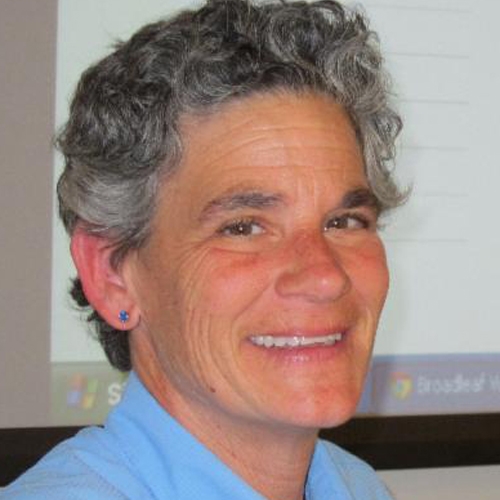
UC Cooperative Extension integrated pest management advisor Cheryl Wilen retired in April after serving UC Agriculture and Natural Resources in a wide variety of leadership and academic capacities during her 25-year career. To help with transitions in the San Diego County UCCE office, Wilen accepted a six-month assignment in May to continue serving as interim director.
Wilen earned a bachelor's degree in horticulture at the University of Maryland, a master's degree in horticulture at University of Arizona and a doctoral degree at UC Riverside. Following graduation, Wilen worked a year at UC Riverside as a post-doctoral fellow.
In 1995, Wilen was hired by UC ANR to conduct applied research in the turf, ornamental horticulture and nursery industries to develop and promote the use of integrated pest management in San Diego, Los Angeles and Orange counties. She shared her results and information generated by scientists across the university with growers and pest control advisers to reduce the use of toxic pesticides, cut the cost of pest control and use environmentally sound methods in production.
Over the years, Wilen was frequently tapped to take on leadership roles while maintaining her academic program. She served as acting and interim director of the Statewide UC IPM Program, program leader of UCCE's Endemic and Invasive Pests and Diseases Strategic Initiative, and as county director in San Diego County. Wilen also had opportunities to take sabbatical and study leaves to improve her Spanish-speaking skills, learn about international participatory extension methodology and receive training on research methods to study snails and slugs.
“I love working with UC Agriculture and Natural Resources,” Wilen said. “The positions I held matched well with my professional and personal style. I always felt that I was responsible for choosing my destination and the journey to get there, whether that was my career or my research and extension programs.”
Wilen said she also valued the relationships she developed over the years in her job.
“I met and became friends with people in UC that I would never have been so lucky to know without the opportunities afforded me by serving on diverse committees,” Wilen said.
Wilen has been awarded the honor of emeritus status, which will continue her academic relationship with UCCE even after her stint in the director post is complete.
“I have a couple of grants I'm continuing to work on,” she said.
She also has plans to do things that she didn't have time for while working full time.
“Plans for my free time include entering sweepstakes, organizing electronics cables, continuing to paddle with my outrigger canoe club, exploring the outdoors, travel, volunteering and enjoying time with my partner and the rest of my family,” she said
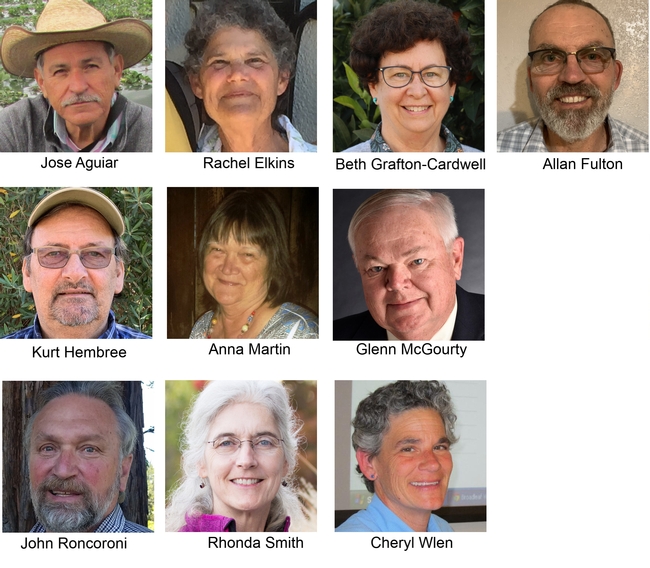
UC ANR's 2020 academic retirees.
Where there is fire, is there smoke flavor in winegrapes?
UPDATED: Viticultural area is Kelsey Bench, not Kelseyville Bench.
UC Cooperative Extension study shows smoke damage to grapes not uniform across vineyards
By the time the Mendocino Complex Fires were officially contained on Oct. 4, 2018, five weeks after igniting, they had burned approximately 450,000 acres in Colusa, Lake, Glenn and Mendocino counties, making it the largest wildfire in California history, according to CalFire.
The fire not only destroyed 280 homes and other buildings, its smoke destroyed the market for wine grapes grown in vineyards near burned areas.
Fearing grapes near the fire would impart smoke flavors to the wine, some wineries rejected all fruit from nearby regions of Lake County and Potter Valley, leaving grape growers to hastily find new destinations for their 2018 crop.
“It can be difficult to determine if fruit has been compromised in quality when exposed to wildfire smoke, and whether or not smoke flavors will result in wine when fermented,” said Glenn McGourty, UC Cooperative Extension advisor in Mendocino County.
A new UC Cooperative Extension study shows wind direction and speed, temperature and a vineyard's proximity to an active fire are factors that can help growers and winemakers predict smoke damage to fruit.
“Fruit in my own vineyard, 60 feet across the street from where the fire started, had no smoke damage because the wind was blowing away from it,” McGourty said.
$41 million hit to wine grape sales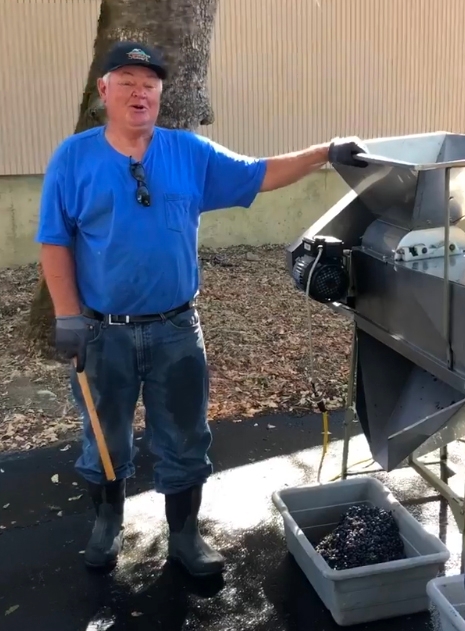
Due to the Mendocino Complex Fires, an estimated $41 million worth of winegrapes, which would have been sold at full price, were impacted – some were sold at a discount, some were sold to other customers, some were custom crushed, while some were left hanging in the vineyard, according to the Lake County Winegrape Commission and Mendocino County Farm Bureau.
The wine industry needed a scientific method of determining whether grapes could be made into a wine untainted by smoke. With funding from the Lake County Winegrape Commission, McGourty formed a workgroup of local growers and winemakers with Anita Olberholster, UC Cooperative Extension enology specialist in the Department of Viticulture & Enology at UC Davis, to research when fruit quality has been compromised.
“The need for industry standards regarding the impact of wildland smoke on winegrapes and the resulting wines has become even more pressing over the past few years,” said Debra Sommerfield, president of the Lake County Winegrape Commission.
Science showed the intensity, duration and timing of the exposure to wildfire smoke affects the grape's uptake. Generally, the closer to harvest, the greater risk to the fruit.
“Both the fruit and wine samples in our study showed a wide range of volatile phenol and glycocide concentrations, indicating that smoke damage to fruit was not uniform across the vineyards sampled,” McGourty said.
Volatile phenols and glycosides create off-flavors
Fresh smoke contains volatile phenols and glycosides that can affect fruit, but these chemicals tend to dissipate in the atmosphere in 1 to 2 hours. Vineyards close to actively burning fires and in the path of fresh smoke are most likely to be affected by smoke taint. Smoke that travels long distances is less likely to affect grapes and the wine made from the fruit.
The combination of volatile phenols and glycosides create “smoke taint” – both aromatic and tactile in the mouth. Wine drinkers may smell smoke or other off flavors and experience a drying of their mouth when high concentrations of the chemicals are present in wine.
“At lower concentrations, smoke taint reminds you of brett-affected wines,” Oberholster explained, referring to the yeast brettanomyces. “There is a shortness of fruit, a kind of dryness in the mouth that you know isn't normal. There may be barely perceptible aromas that aren't normal as well.”
Following wildfire smoke exposure, the researchers sampled fruit from 14 cabernet sauvignon vineyards around the viticultural areas of Lake County, including Upper Lake, High Valley, Big Valley, Kelsey Bench, Red Hills, Lower Lake and Guenoc Valley. As a control, fruit was also sampled from a Napa Valley vineyard that was not exposed to wildfire smoke.
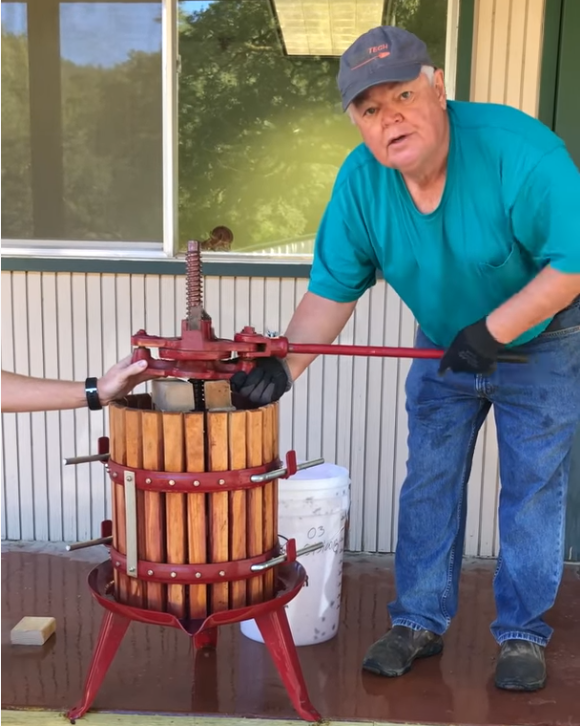
“The volatile phenols guaiacol and 4-methyl guaiacol are detected in the fruit by gas chromatography, so it is possible to sample fruit before harvest to make picking decisions,” McGourty said. “Based on our study, berry sampling and guaiacol/ 4-methyl guaiacol analysis are useful for a quick evaluation of whether or not fruit from a particular vineyard may have the presence of volatile phenols that can potentially result in smoke-affected wine.”
Testing the fruit for volatile phenols and glycosides is both expensive and not completely predictive as standards are not well defined for damage based on smoke chemical concentration, he cautioned.
These two compounds aren't the only ones that cause smoke flavors. More than 70 other compounds in forest fire smoke can also produce undesirable flavors and odors described as “like licking an ash tray, burnt garbage, a burnt potato, a campfire that has been drenched with water.”
The taste test
To assess the levels of the compounds that produce the off-flavors, Oberholster convened a panel of 14 wine industry professionals to taste the sample wines. The wine tasters detected stronger off-flavors in the wines made from riper fruit, which also contained higher concentration of smoke compounds. Less than 6 micrograms per liter of the smoke compounds were difficult for the tasters to detect, leading the researchers to conclude they will have a minimal effect on wine quality.
Smoke from a distant fire
The scientists also looked at the influence of distance from the fire and elevation on smoke taint. They found some vineyards close to the edge of fires and immediately downwind were heavily affected, with the grapes containing high concentrations of the smoke flavor-causing compounds. But they determined elevation was not a factor in smoke flavors in wines.
Wind direction and speed, temperature and vineyard proximity to active fires are highly likely affect whether there will be smoke damage to the fruit, their research showed.
“Smoke generated in the first one or two hours from a wildfire is most damaging to nearby vineyards,” McGourty said. “Even though a vineyard may be enveloped in smoke, if the source of the smoke is from a distant fire, it will probably won't seriously damage the fruit quality because most of the volatile gases are gone.”
Lake County Winegrape Commission's Sommerfield said, “Today, the results of this study are already proving to be useful in deepening our understanding of smoke and the risks it poses to grapes and wine, in enabling grape growers and winery buyers to engage in fruitful discussions and make informed decisions, and, in turn, in helping to propel the development of industry standards and protocols.”
To read more about the study by McGourty, Michael I. Jones, Oberholster and Ryan Keiffer, see the January 2020 edition of Wine Business Monthly at https://www.winebusiness.com/wbm.
“This is a great little study, the first one that I know of that takes a systems approach to evaluating the effects of wildfire smoke,” said McGourty.
Glenn McGourty, UCCE viticulture advisor for Mendocino County, describes for Hannah Bird the UC project to analyze the effect of wildfire smoke on winegrapes.
To save cabernet from climate change, UC studies rootstock and clone combinations
UC Cooperative Extension, Beckstoffer Vineyards and Duarte Nursery are launching the wine industry's most ambitious cabernet sauvignon rootstock and clone trial in the Red Hills of Lake County to give the varietal greater resilience to climate change.
Cabernet sauvignon is California's second top-selling varietal by volume, just behind chardonnay.
“We have been growing cabernet sauvignon since the 1970s, and we are very proud to be part of this trial, which will help improve cabernet sauvignon growing for years to come,” said Andy Beckstoffer, owner and CEO of Beckstoffer Vineyards, which is providing the land and labor for the project.
The industry-driven trial – “Climate-smart Solutions for Cabernet Sauvignon Production” – includes 3,600 vines with 10 cabernet sauvignon clones on 10 rootstocks.
“This trial will give us data that will help inform and improve growing practices for cabernet sauvignon across the state for the next two decades,” said the trial's lead researcher, S. Kaan Kurtural, UC Cooperative Extension viticulture specialist at UC Davis Department of Viticulture and Enology and Oakville Experiment Station.
While the experimental vineyard is in Lake County at a property known as Amber Knolls, the data will be analyzed in Oakville.
The trial officially launched Aug. 15 in Kelseyville with a celebratory vine planting as Andy Beckstoffer and son David Beckstoffer planted the vine that also marked a milestone – the 1.5 millionth vine for Beckstoffer Vineyards Red Hills. Researchers, industry representatives and journalists gathered to celebrate what is affectionately known as “the mother of all cabernet trials.”
“Everything is wonderful in Lake County – for growing cabernet sauvignon and for doing research,” Andy Beckstoffer said, noting the Lake County region's ongoing support for farming.
Pedro Rubio, Beckstoffer Vineyards Red Hills general manager, said, “Lake County will definitely benefit, but the results from this trial will be very helpful for the whole industry.”
Designed to address resiliency in a changing climate, the trial will examine which combinations give the best results with a focus on drought tolerance and water-use efficiency as well as crop yield and grape quality.
“The idea behind the trial is to gain further insights into the interactive effects of rootstock selections crossed with cabernet clones and the impact of that on water relations and overall sustainability,” said Clint Nelson, ranch manager for Beckstoffer Vineyards Red Hills.
“The trial will give us an understanding of the synergistic relationship of clone and rootstock and what combination drives the best quality and production,” he said.
According to Nelson, the trial will look at canopy architecture, yield components, water relations, traditional fruit chemistries, secondary metabolites such as aroma, mouthfeel and color, as well as overall vine performance.
Duarte Nursery is providing all of the planting material for the trial.
“The diversity of rootstocks and clones chosen for this project includes some of the most modern cabernet sauvignon clones designed for high quality and for production,” said John Duarte, nursery president.
Duarte said the trial is employing a lot of cutting-edge technology and using some of the cleanest plant materials available to prevent grapevine viruses.
“Planting a vineyard with pristine nursery stock initially really extends the life of that vineyard,” Duarte said.
Viticulture has become more data-driven, and this trial will measure a staggering amount of data generated by the 100 or so rootstock-clone combinations over the approximately eight to 10 years of the trial's duration.
“Nothing of this scope has been attempted,” said UC Cooperative Extension specialist Kurtural, who acknowledged logistics as the biggest challenge with planning, data collection and timely analysis being at the forefront of his mind. “It keeps me up at night.”
Planning for the length of the project also is a concern. The vineyard will be planted this year and the first crop will be harvested in 2021. It will take at least six years to begin to see consistent results.
Kurtural said the project will provide research opportunities in academic and applied science for at least two students to complete work toward a doctoral degree in horticulture and agronomy.
Glenn McGourty, UC Cooperative Extension viticulture advisor for Lake and Mendocino counties, is a research collaborator on the project.
“Lake County obviously has an important role to play in fine wine in the North Coast, particularly for cabernet sauvignon,” McGourty said. “And this trial really marks the importance of this location in terms of the commitment and the collaboration that we see here among both public and private sectors.”
About Beckstoffer Vineyards: Named “Napa's most powerful grape grower” by both the Wall Street Journal and Wine Spectator, Beckstoffer Vineyards was founded in 1970. Beckstoffer Vineyards is firmly rooted in the soil of Northern California's wine country, with Andy Beckstoffer playing an integral role in the evolution of the wine grape industry since 1970. Joined at the family-owned business by his son David in 1997, they share a common mission – to produce the highest quality grapes in Northern California that form the foundation for exceptional wines – and a combined passion for the land and viticulture expertise. Beckstoffer Vineyards first acquired land in the Red Hills in 1997, which after subsequent acquisitions, today totals nearly 2,000 planted acres across three blocks: Amber Knolls Vineyard, Crimson Ridge Vineyard, and Amber Mountain Vineyard.
About Duarte Nursery: Duarte Nursery, Inc. (DNI) is a family-owned and operated nursery and the largest permanent crops nursery in the United States.
UC Cooperative Extension works in local communities to help Californians adapt to climate change
Californians received bleak news last month when the state released its fourth assessment of climate change in California. The report predicts severe wildfires, more frequent and longer droughts, rising sea levels, increased flooding, coastal erosion and extreme heat.
“It's great to be living in a state where science and facts around climate change are valued,” said UC Cooperative Extension specialist Adina Merenlender, “but the recent forecasts may make you want to devour a quart of ice cream in a pool of salty tears.”
Modern civilization has changed the world climate, and even dramatic reductions in global greenhouse gas emissions at this point won't turn back the clock. The warming now predicted by Cal-Adapt is likely already “baked in,” even with our best mitigation efforts, said Igor Lacan, UC Cooperative Extension advisor in the Bay Area of California.
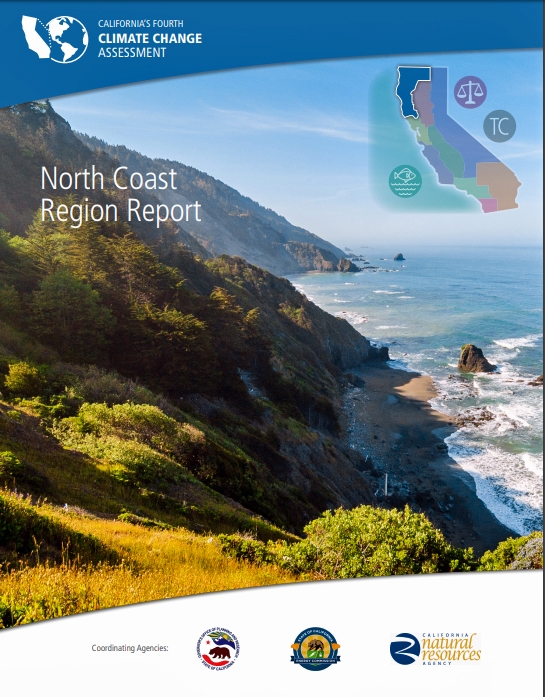
California has been a leader in facing the future climate head on. The state's first comprehensive assessment on climate change was produced in 2006 under then-Gov. Arnold Schwarzenegger. The second assessment, released in 2009, concluded that adaptation could reduce economic impacts of loss and damage from a changing climate. The third assessment was shaped by a request for more information on the adaptation options in the 2009 report. The fourth assessment was the first effort to break down global climate predictions and their impacts onto specific regions of California.
Author of the North Coast Region Report of the Fourth Assessment, Ted Grantham, praised state leaders for pushing forward efforts to slow climate change and adapt to the new weather conditions expected in California.
“California is playing a unique role in filling the void of leadership on this issue that the federal government was beginning to address under the Obama administration,” Grantham, a UC Cooperative Extension specialist based at UC Berkeley, said.
Across California, UC Cooperative Extension specialists and advisors are working in their local communities to prepare for warming temperatures and adapt to the changing climate. Following are examples of the efforts now underway.
Managing forests to survive the future
Among the suggested adaptation strategies in the 81-page North Coast Region Report, written by Grantham and his colleagues, the authors encourage government agencies and private forest owners to use prescribed fires and active forest management to reduce an overgrowth of trees and shrubs that fuel the more frequent and intense fires expected in the future.
Although climate change will create conditions conducive to catastrophic wildfire, the reason for dangerous forest overgrowth is related to decades of fire suppression on the landscape.
“Our forests are much denser and have more fuel buildup than they would have under a natural fire regime,” Grantham said. “Mechanical thinning, removing wood from the landscape and prescribed fires can help limit the impacts of wildfire.”
Native American tribes are being tapped to share their traditional ecological knowledge to inform this practice.
“Native Americans have used fire since time immemorial to manage their landscapes,” Grantham said.
Connecting habitats to allow species movement
When climate changes, plant and animal species may find their current habitats no longer fit the environment where they evolved. The fourth assessment technical report, Climate-wise Landscape Connectivity: Why, How and What Next, written by UCCE specialist Adina Merenlender, documented potential techniques to erase barriers to plant and animal movement.
“When we talk about wildlife corridors today, we might view a road as a barrier,” Merenlender said. “With climate change, the movement is over a much longer range for species to find suitable habitat at the end of the century.”
The report says research is needed to compare different approaches to designing climate-wise connectivity, determining how wide corridors need to be, and quantifying the impact of natural and anthropogenic barriers on possible range shifts.
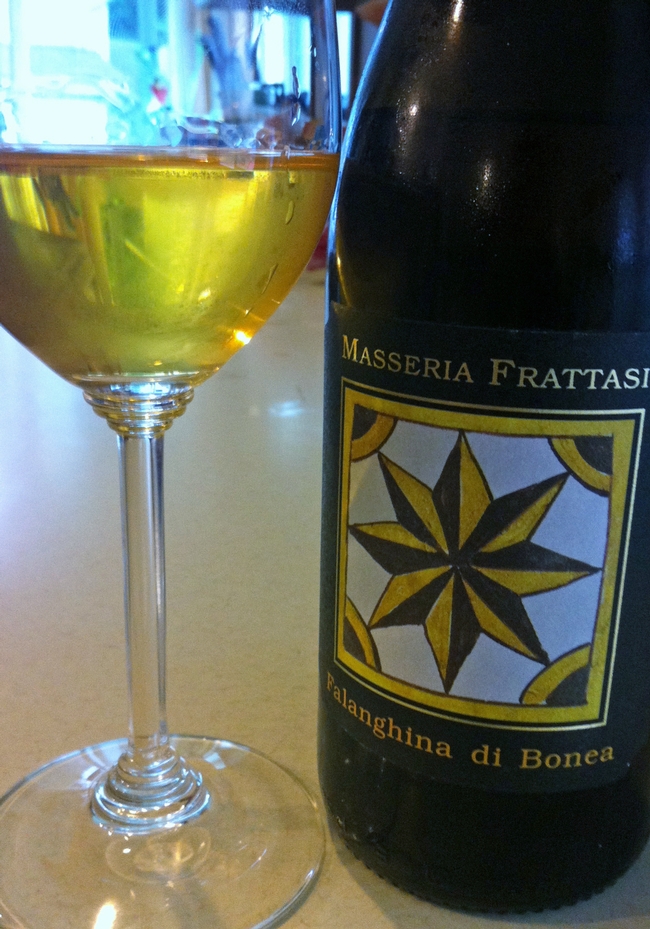
California's wine industry is based on international varieties that come from Northern France, where the climate is cool, mild and consistent.
“They really require a cool to warm climate, not a hot climate,” said Glenn McGourty, UCCE viticulture advisor in Mendocino County.
There are many wine grape cultivars from Southern Europe – areas in Italy, Portugal and Spain – that are adapted to heat and make quality wines, but aren't well known. The varieties include Monepulciano, Sagrantino, Periquita and Graciano.
McGourty is studying how these cultivars perform in the warm interior of Mendocino County at the UC Hopland Research and Extension Center.
“We have many options as climates warm in the interior part of California to make wine that needs less amelioration in the winery compared to cultivars from Northern France,” McGourty said.
Recruiting and training climate stewards
The UC California Naturalist Program is moving full steam ahead with a new Climate Stewards Initiative to build engaged communities and functioning ecosystems that are resilient to changing climates.
California Naturalist, with trained volunteers across the state working with myriad conservation organizations, will be using its educational network to improve the public's understanding of climate change and engage the public in community action and local conservation.
“Climate stewards will offer in-person communication with your neighbors, tapping into science,” Merenlender said. “Improving climate literacy is an important outcome, but that won't happen through a website.”
Helping growers modify farming practices due to changing climate
USDA Climate Hub has awarded a grant to UC Cooperative Extension to support tools to assist growers in making strategic decisions in season and long term.
“We have many credible sources of weather and climate data, but often times we are challenged with translating it into decision support tools tailored to growers' needs,” said Tapan Pathak, UCCE specialist in climate change adaptation in agriculture. “It's too early to say which specific tools we will develop, but we are aiming to help farmers use weather and climate information in decision making processes.”
Pathak is also working with colleagues to analyze how generations of navel orangeworm, a significant almond pest, might shift for the entire Central Valley under climate change and how growers can adapt their practices to manage the higher pest pressure.
Using epigenetics to impart drought tolerance
At the UC Kearney Agricultural Research and Extension Center in Parlier and the UC West Side Research and Extension Center in Five Points, sorghum nurseries are being grown under drought and well-watered conditions to compare the environmental impacts on the plants' gene expression.
“We hope to tease out the genetics of drought tolerance in sorghum,” said Jeff Dahlberg, UCCE specialist, who is managing the trials at Kearney. “Using sorghum as a model, we expect this research to help us understand drought tolerance in other crops as well.”
Historically, the genetic manipulation of crops, which has been critical to increasing agricultural productivity, has concentrated on altering the plant's genetic sequence, encoded in its DNA.
Recent studies have shown that environmental stresses – such as drought – can lead to epigenetic changes in a plant's genetic information. Because epigenetic changes occur without altering the underlying DNA sequence, they allow plants to respond to a changing environment more quickly.
Cities can plant street tree species suited to future climate
Many common street trees now growing in the interior of California are unlikely to persist in the warmer climate expected in 2099, according to research published in the July 2018 issue of the journal Urban Forestry & Urban Greening. (Read the research report here until Sept. 27, 2018)
“Urban foresters in inland cities of California should begin reconsidering their palettes of common street trees to prepare for warmer conditions expected in 2099 due to climate change,” said the study's co-author, Igor Lacan, UC Cooperative Extension environmental horticulture advisor in the Bay Area.
Common trees in Coastal California cities appear to be better suited to withstand the 2099 climate.
“Our research shows that some trees now lining the streets of cities like Fresno, Stockton and Ukiah are likely to perform poorly in 2099,” Lacan said. “Those cities need to look at the conditions – and trees – now found in El Centro, Barstow and Fresno respectively.”
Trees to shade California in a warmer future
The changing climate predicted for California – including less rain and higher day and nighttime temperatures – is expected to cause chronic stress on many street tree species that have shaded and beautified urban areas for decades.
Realizing that popular trees may not thrive under the changing conditions, UC Cooperative Extension scientists are partnering with the U.S. Forest Service in a 20-year research study to expand the palette of drought-adapted, climate-ready trees for several of the state's climate zones.
“The idea is to look at available but under-planted, drought-tolerant, structurally sound, pest resistant trees for Southern California that do well in even warmer climates,” said Janet Hartin, UCCE horticulture advisor in San Bernardino County.
Twelve tree species were selected for each climate zone in the comparative study, with several area parks used as control sites.
Managing the forest for survival in warmer conditions
UC Cooperative Extension scientists are part of a collaborative research project with the University of Nevada, Reno, CAL FIRE and the U.S. Forest Service aimed at developing new strategies to adapt future forests to a range of possible climate change scenarios in the Sierra Nevada.
“It includes the idea that we may be struggling just to keep forests as forests, let alone having the species we value,” said Rob York, manager of UC Berkeley's Blodgett Forest Research Station near Georgetown.
Forests sequester a tremendous amount of carbon. As the climate changes, foresters will need to be proactive to reduce the risk of these massive carbon sinks becoming carbon sources.
“We're working to mitigate predicted impacts to forests, including regeneration failures, drought mortality and catastrophic wildfire,” Ricky Satomi, UCCE natural resources advisor in Shasta County.
At three separate study sites across the Sierra Nevada, novel approaches to forest management are being implemented to develop treatments that scientists believe will increase resilience, resistance and adaptability of Sierra Nevada mixed conifer forests.
The 2018-21 project is led by Sarah Bisbing, forest ecology professor at the University of Nevada, Reno, and funded with $2.7 million from CAL FIRE.
Climate change impacts on vulnerable communities
The latest climate assessment also reports on the serious nature of climate threats to vulnerable communities and tribal communities in California, with a focus on working collaboratively with these communities on research and solutions for resilience.
“The impacts of climate change will not be experienced equally among the population,” Grantham said. “The most significant public health and economic impacts – from flooding, extreme heat, air quality degradation, etc. – will be disproportionately experienced by vulnerable populations, including people of color, the poor and the elderly.”
The assessment includes a Climate Justice Report, which shares the idea that no group of people should disproportionately bear the burden of climate impacts or the costs of mitigation and adaptation. The report suggests collaborating with these communities on research and solutions for resilience.


